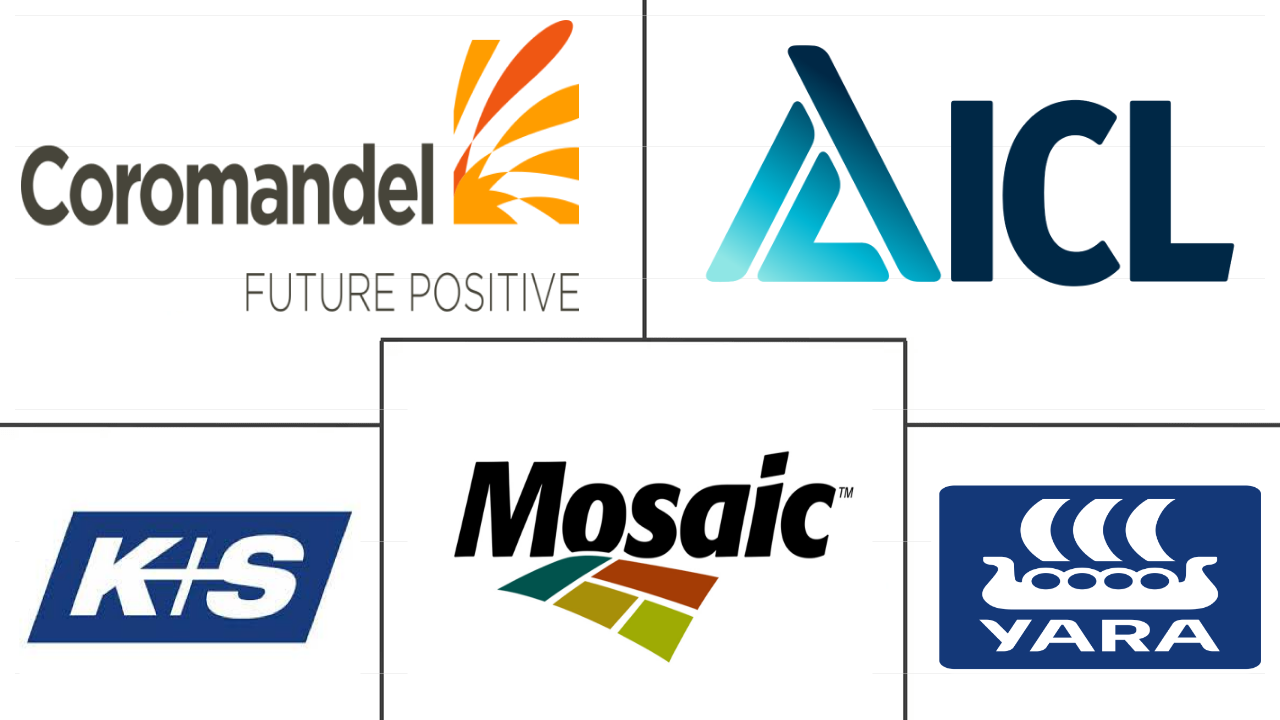Market Size of micronutrient fertilizer Industry
|
|
Study Period | 2017 - 2030 |
|
|
Market Size (2024) | USD 5.6 Billion |
|
|
Market Size (2030) | USD 8.25 Billion |
|
|
Largest Share by Product | Copper |
|
|
CAGR (2024 - 2030) | 6.69 % |
|
|
Largest Share by Region | Asia-Pacific |
Major Players |
||

|
||
|
*Disclaimer: Major Players sorted in no particular order |
Micronutrient Fertilizer Market Analysis
The Micronutrient Fertilizer Market size is estimated at 5.6 billion USD in 2024, and is expected to reach 8.25 billion USD by 2030, growing at a CAGR of 6.69% during the forecast period (2024-2030).
5.6 Billion
Market Size in 2024 (USD)
8.25 Billion
Market Size in 2030 (USD)
5.38 %
CAGR (2017-2023)
6.69 %
CAGR (2024-2030)
Largest Segment by Type
23.57 %
value share, Copper, 2023
Copper sulfate is the preferred source of copper fertilizer because they are cheaper and more readily available in the market than chelated copper sources.
Fastest Growing Type
7.56 %
Projected CAGR, Boron, 2024-2030
Boron is an important micronutrient for plant growth, the rising need to address deficiency to improve crop yield and quality is driving the demand for boron fertilizers.
Largest Segment by Crop Type
84.37 %
value share, Field Crops, 2023
The need for high productivity and higher resistance to biotic and abiotic stresses of the crops has increased the demand for micronutrients in field crop segment.
Largest segment by Country
13.35 %
value share, United States, 2023
Farmers in the United States are increasingly aware of soil nutrient deficiencies impacting crop health and yields which has contributed to the it's dominance in the market.
Leading Market Player
25.04 %
market share, Yara International ASA, 2022

Yara International has expanded its micronutrient product portfolio and production facilities to meet the growing demand which has contributed to secure a significant share
The rising micronutrient deficiency in soil is expected to fuel the growth of the micronutrient fertilizer market
- Micronutrients play an important role in many plant metabolic activities, such as cell wall formation, pollen formation, germination, chlorophyll production, nitrogen fixation, and the synthesis of the essential parts of proteins. The global micronutrient fertilizer market value is anticipated to register a CAGR of 6.6% during 2023-2030.
- Zinc accounted for a major share of 26.6% of the global micronutrient fertilizer market value in 2022. Of the total value share held by zinc fertilizers, conventional zinc fertilizers accounted for about 87.5%, and specialty zinc fertilizers accounted for about 12.5%. Specialty zinc fertilizers have the advantage of uniform distribution and fast acting on crops compared to conventional fertilizers.
- The Asia-Pacific region dominated the global market, accounting for 33.3% of the market value share in 2022. The distribution network of micronutrient fertilizers is well-established in the major Asia-Pacific countries, further boosting the market for various micronutrient fertilizer products in the region. The increasing demand for food grains, coupled with decreasing nutrients in the soil, is one of the major factors driving the growth of the market in the region. Recent studies have indicated that zinc deficiency is China's most widespread micronutrient deficiency. More than 50.0% of the arable soils are low in zinc, thereby limiting agricultural growth and improvement in human nutrition.
- Widespread micronutrient deficiencies worldwide are becoming a rising concern for plant health, coupled with increasing encouragement from various government agencies and other organizations to improve the use of micronutrients to enhance plant and soil health, which is driving the growth of the market.
The increase in micronutrient deficiencies increases the demand for micronutrient fertilizers
- The global micronutrient fertilizer market grew at a stable rate during the study period, with a value of USD 5.70 billion in 2022. Asia-Pacific occupied the largest market share of 38.8% in 2022, followed by Europe and North America.
- Countries such as India and China are the major micronutrient fertilizer markets, accounting for 13.9% and 10.5% of the market share in 2022, respectively. The increase in micronutrient deficiency in Chinese crops resulted in 31.4% of micronutrient fertilizer consumption in 2022. The Ministry of Agriculture (MoA) of China added zinc, at a rate of 15-30 ZnSO4 kg/ha, to its national fertilizer recommendation, which was recently extended for summer crops like rice and corn.
- France is the major market for micronutrient fertilizer in Europe, followed by Ukraine, with a market value of USD 218.4 million in 2022. The area under the cultivation of horticultural crops decreased from 17.4 million hectares in 2017 to 15.6 million hectares in 2022. However, the figure is expected to increase further in the following years.
- Apart from Asia, zinc and iron deficiency in the soil is quite widespread in Sub-Saharan Africa and northwest South America. The overall advantages of micronutrient fertilizers are being widely accepted and recognized. The global export value of zinc in 2021 amounted to USD 1.6 million, with the Netherlands as the top exporter of the micronutrients, with a value of USD 275.6 thousand.
- The market is growing because of the widespread micronutrient deficiencies around the world, with iron and zinc deficiencies becoming a rising concern for plant health, and also due to the increasing encouragement from various government agencies to increase the use of micronutrients.
Micronutrient Fertilizer Industry Segmentation
Boron, Copper, Iron, Manganese, Molybdenum, Zinc, Others are covered as segments by Product. Fertigation, Foliar, Soil are covered as segments by Application Mode. Field Crops, Horticultural Crops, Turf & Ornamental are covered as segments by Crop Type. Asia-Pacific, Europe, Middle East & Africa, North America, South America are covered as segments by Region.
- Micronutrients play an important role in many plant metabolic activities, such as cell wall formation, pollen formation, germination, chlorophyll production, nitrogen fixation, and the synthesis of the essential parts of proteins. The global micronutrient fertilizer market value is anticipated to register a CAGR of 6.6% during 2023-2030.
- Zinc accounted for a major share of 26.6% of the global micronutrient fertilizer market value in 2022. Of the total value share held by zinc fertilizers, conventional zinc fertilizers accounted for about 87.5%, and specialty zinc fertilizers accounted for about 12.5%. Specialty zinc fertilizers have the advantage of uniform distribution and fast acting on crops compared to conventional fertilizers.
- The Asia-Pacific region dominated the global market, accounting for 33.3% of the market value share in 2022. The distribution network of micronutrient fertilizers is well-established in the major Asia-Pacific countries, further boosting the market for various micronutrient fertilizer products in the region. The increasing demand for food grains, coupled with decreasing nutrients in the soil, is one of the major factors driving the growth of the market in the region. Recent studies have indicated that zinc deficiency is China's most widespread micronutrient deficiency. More than 50.0% of the arable soils are low in zinc, thereby limiting agricultural growth and improvement in human nutrition.
- Widespread micronutrient deficiencies worldwide are becoming a rising concern for plant health, coupled with increasing encouragement from various government agencies and other organizations to improve the use of micronutrients to enhance plant and soil health, which is driving the growth of the market.
| Product | |
| Boron | |
| Copper | |
| Iron | |
| Manganese | |
| Molybdenum | |
| Zinc | |
| Others |
| Application Mode | |
| Fertigation | |
| Foliar | |
| Soil |
| Crop Type | |
| Field Crops | |
| Horticultural Crops | |
| Turf & Ornamental |
| Region | |||||||||||||
| |||||||||||||
| |||||||||||||
| |||||||||||||
| |||||||||||||
|
Micronutrient Fertilizer Market Size Summary
The Micronutrient Fertilizer Market is poised for significant growth, driven by the essential role micronutrients play in plant metabolic activities such as chlorophyll production and nitrogen fixation. The market is experiencing a robust expansion, with a notable increase in demand due to widespread micronutrient deficiencies affecting plant health globally. The Asia-Pacific region leads the market, supported by a well-established distribution network and a rising need to address soil nutrient depletion. This region's dominance is further bolstered by countries like China and India, where micronutrient deficiencies are prevalent, prompting increased fertilizer consumption. The market's growth is also fueled by government initiatives encouraging the use of micronutrients to enhance agricultural productivity and soil health.
Globally, the demand for micronutrient fertilizers is on the rise as farmers seek to boost crop yields to meet the food production demands of a growing population. The market is moderately consolidated, with major players like Coromandel International Ltd., ICL Group Ltd, K+S Aktiengesellschaft, The Mosaic Company, and Yara International ASA leading the charge. Recent strategic acquisitions and product launches by these companies indicate a proactive approach to expanding their market presence and enhancing their product offerings. The increasing application rates of micronutrients in various regions, particularly in Asia-Pacific, South America, and North America, highlight the growing recognition of the benefits of micronutrient fertilizers in improving crop yields and soil health.
Micronutrient Fertilizer Market Size - Table of Contents
-
1. MARKET SEGMENTATION (includes market size in Value in USD and Volume, Forecasts up to 2030 and analysis of growth prospects)
-
1.1 Product
-
1.1.1 Boron
-
1.1.2 Copper
-
1.1.3 Iron
-
1.1.4 Manganese
-
1.1.5 Molybdenum
-
1.1.6 Zinc
-
1.1.7 Others
-
-
1.2 Application Mode
-
1.2.1 Fertigation
-
1.2.2 Foliar
-
1.2.3 Soil
-
-
1.3 Crop Type
-
1.3.1 Field Crops
-
1.3.2 Horticultural Crops
-
1.3.3 Turf & Ornamental
-
-
1.4 Region
-
1.4.1 Asia-Pacific
-
1.4.1.1 Australia
-
1.4.1.2 Bangladesh
-
1.4.1.3 China
-
1.4.1.4 India
-
1.4.1.5 Indonesia
-
1.4.1.6 Japan
-
1.4.1.7 Pakistan
-
1.4.1.8 Philippines
-
1.4.1.9 Thailand
-
1.4.1.10 Vietnam
-
1.4.1.11 Rest of Asia-Pacific
-
-
1.4.2 Europe
-
1.4.2.1 France
-
1.4.2.2 Germany
-
1.4.2.3 Italy
-
1.4.2.4 Netherlands
-
1.4.2.5 Russia
-
1.4.2.6 Spain
-
1.4.2.7 Ukraine
-
1.4.2.8 United Kingdom
-
1.4.2.9 Rest of Europe
-
-
1.4.3 Middle East & Africa
-
1.4.3.1 Nigeria
-
1.4.3.2 Saudi Arabia
-
1.4.3.3 South Africa
-
1.4.3.4 Turkey
-
1.4.3.5 Rest of Middle East & Africa
-
-
1.4.4 North America
-
1.4.4.1 Canada
-
1.4.4.2 Mexico
-
1.4.4.3 United States
-
1.4.4.4 Rest of North America
-
-
1.4.5 South America
-
1.4.5.1 Argentina
-
1.4.5.2 Brazil
-
1.4.5.3 Rest of South America
-
-
-
Micronutrient Fertilizer Market Size FAQs
How big is the Global Micronutrient Fertilizer Market?
The Global Micronutrient Fertilizer Market size is expected to reach USD 5.60 billion in 2024 and grow at a CAGR of 6.69% to reach USD 8.25 billion by 2030.
What is the current Global Micronutrient Fertilizer Market size?
In 2024, the Global Micronutrient Fertilizer Market size is expected to reach USD 5.60 billion.

